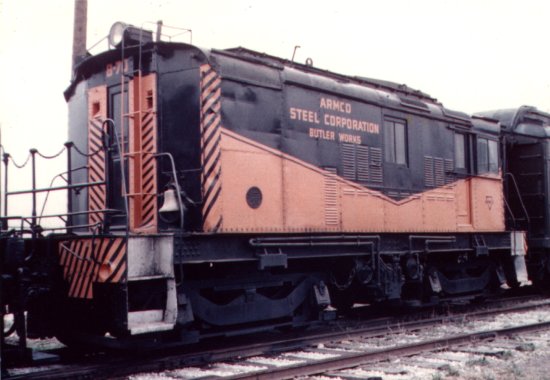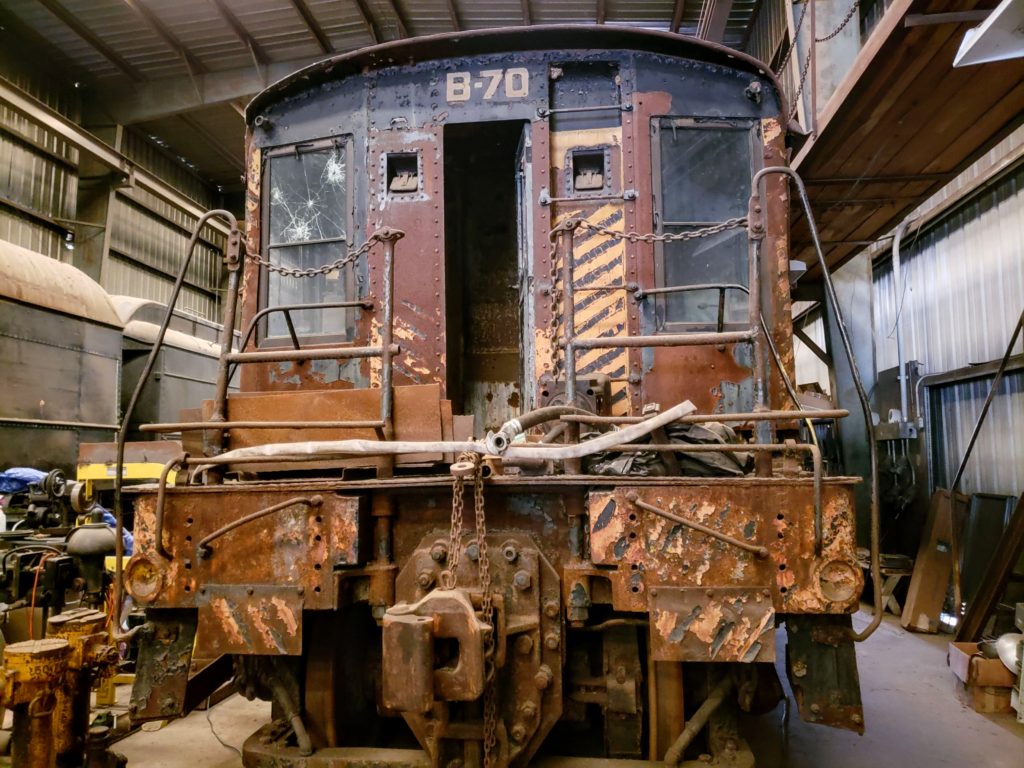A Dive in the Archive: The B-70
by Paul Grether

To most visitors to our museum who dare venture into the ‘back’ to explore, our B-70 Diesel locomotive is no more than a strange piece of junk. However, a dive into the archives in our library tell a different story.
When discussions take place about the Dieselization of America’s railroads, inevitably the story of the Electro-Motive Corporation and General Motors E- and F- units comes up and how they revolutionized American railroading and killed the steam engine. This is not the whole story. Dieselization was a very grass-roots effort in the beginning, the period between the two world wars. Companies like Baldwin, Alco, General Electric, Ingersol Rand, and Westinghouse Electric and Manufacturing laid the groundwork for producing a stable prime-mover that was destined to eliminate external combustion engines.
The story of the B-70 lies with Baldwin and Westinghouse. Westinghouse was purchasing straight-electric locomotive mechanical portions from Baldwin to build Diesels. Westinghouse had obtained a license from The Beardmore Company in Glasgow to build Beardmore Diesel engines in the United States rather than having to import them from Scotland. It had helped build locomotives for the Long Island RR and Canadian National with Beardmore prime-movers, which were very successful. The most promising market for Diesel-electric locomotives at the time seemed to be in the switcher type. Diesels could start at a moments notice and stop as well, and this paid off the most in the switcher environment, where crew cost went down tremendously.
Westinghouse built its first switcher of its own design in late 1928, a demonstrator, Westinghouse #7. It was a box-cab with the car body being built by Westinghouse and was of traditional riveted construction. It was mounted on an electrically welded fabricated steel underframe, a first for Diesel locomotives. Completed in December, it had no construction number and was identified only by shop number XE91300 under which it was built. Westinghouse #7 was one of the only two car bodies built by Westinghouse for Westinghouse-Beardmore locomotives. Its purpose was to establish competitive manufacturing costs for obtaining locomotive mechanical portions. The power for #7 was a Beardmore-built 6 cylinder in-line 8¼”x12″ engine rated 300 horsepower at 800 rpm identified by Westinghouse serial #13. The electric transmission consisted of a model 477 main generator which supplied four model 562D6 traction motors that drove the 33″ wheels through 16:61 gearing. The continuous TE rating was 8,800 lbs. a t 10.2 mph and the one hour rating was 17,800 lbs. The maximum safe speed was 30mph. Following a period of successful demonstration #7 was returned to East Pittsburgh where it served as the Westinghouse plant switcher.
#7 caused the Western Electric Company of Baltimore to order a Diesel switcher box-cab from Westinghouse. It was completed in February of 1929 and became Western Electric Company #1. It varied little from #7, there were a few performance upgrades incl uded in the Westinghouse electrical system but it was also powered by the same Beardmore 300hp engine. However the mechanical portion was built by Baldwin at Eddystone and assigned BLW construction number 60676. It was assigned Westinghouse serial #9. In 1935 the prime-mover was replaced by Westinghouse-built engine serial #49.
Delivery of a longer and heavier model took place in August 1929. This unit was sold to the American Rolling Mill Company at Butler, Penn. (later Armco Steel) and was assigned road number B-70. The locomotive was essentially an enlargement of Westinghouse #7. It weighed 149,000 lbs. and was 35′ 2″ over couplers. The mechanical portion of this locomotive riveted steel construction and built by Baldwin at Eddystone under construction number BLW 60759. The gear ratio was changed to 15:70 and 38″ wheels were used. A model 477B main generator and four model 582FE6 traction motors were used, resulting in a continuous TE rating of 20,000 lbs. at 4.0 mph. The maximum safe speed was 35mph. It had the same Beardmore 6 cylinder engine as #7 (Westinghouse serial #11), but this was later replaced by a Westinghouse built engine built under license with serial #29. This was the last Westinghouse engine to be built with a box-cab, subsequent orders utilized the new ‘visibility-cab’ (steeple-cab) car body like NYC S-class straight electrics. The B-70 was also the last Westinghouse locomotive to be equipped with an imported Beardmore engine.
Westinghouse learned a lot from observing #7, Western Electric #1, and the B-70 in action, and incorporated many design changes into the Beardmore 8¼”x12″ engine using this new knowledge. These changes were directed toward obtaining cost-savings, in creased reliability, simplification in manufacture, and an increase in horsepower ratings. Thus, when installed in locomotives, these new Westinghouse-built 8¼”x12″ engines were normally rated 400 horsepower at 900 rpm. The B-70 was a major step in Westinghouse/Baldwin Diesel locomotive design in not only domestic prime-mover development, but also in securing the long relationship between Baldwin and Westinghouse who would together continue to build Diesel locomotives well through the end of Steam on America’s Railroads.
What’s left? Well, the B-70 sat in the back of the museum’s lot at the old site for 30+ years after it was donated. It went though a design change at Armco to simplify operations, it had one of its cabs removed and became what in reality is a single-ended box cab, which is rare indeed. Inside still is the 400 horsepower Westinghouse upgraded Beardmore engine. As far as the B-70’s offspring are concerned, the B-73, which is technically basically the same as the B-70 but with Westinghouse’s ‘visibility cab ‘ carbody, still operates at the Pennsylvania Trolley Museum, who claims that it is the oldest operating Diesel locomotive in North America. There are a lot of steam engines younger than these Diesels. Unfortunately, an aborted restoration attempt left panels missing from B-70’s sides and roof, allowing Mother Nature free reign for a decade or so, so our Westinghouse switcher is not in pristine shape, but it is an artifact nonetheless. Since the museum’s move in 1998 to a new site, the B-70 has been preserved under cover for the last 20 years inside the museum’s shop building.

Sources:
- Kirkland, John F., Dawn of the Diesel Age (A history of the Diesel Locomotive in America). Interurban Press, Glendale CA, 1983.
(Info on Westinghouse #7 and B-70 and photos). - “Locomotive and Railway Preservation”: Moving the Masses: Pennsylvania Trolley Museum by Scott R. Becker. Issue #50 Nov./Dec. 1994.
(Great picture of B-73 when new). - Wiring schematics B-70: Westinghouse.
- Blueprints for the B-70 carbody: BLW.
- Lots and lots of other miscellaneous documentation on the B-70 in our RPO.
